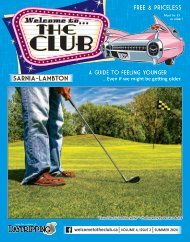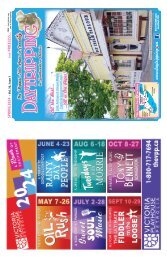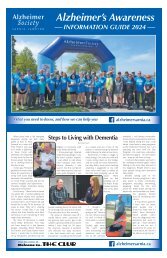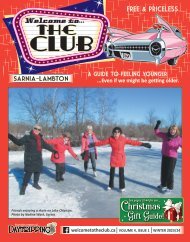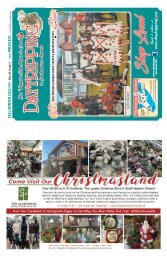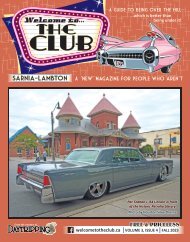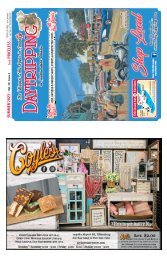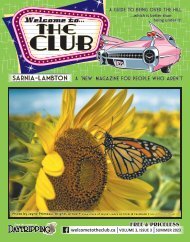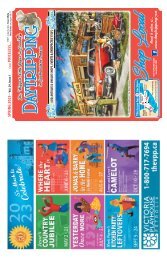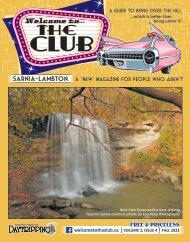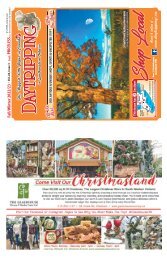Daytripping Summer 2022
Daytripping is a Free Magazine filled from start to finish with all of the best Odd, Antique & Unique Shops, Events & Unexpected Stops
Daytripping is a Free Magazine filled from start to finish with all of the best Odd, Antique & Unique Shops, Events & Unexpected Stops
Create successful ePaper yourself
Turn your PDF publications into a flip-book with our unique Google optimized e-Paper software.
...and then wanders town by town, to unique shops and stops in SW Ontario<br />
The Really Big Carrots<br />
By Vicki Hornick, Tilbury<br />
Growing up in a large farm family,<br />
planting the garden was an annual right<br />
of spring.<br />
Dad worked hard raising the hogs<br />
as well as planting and harvesting<br />
cash crops, like wheat and soy beans.<br />
The thing is, despite being called cash<br />
crops; they did not bring in<br />
much cash. Thus, practical,<br />
reliable, frugal dad rallied<br />
his troops each spring to<br />
plant the garden.<br />
With the meat of one of<br />
the hogs in a freezer and<br />
the vegetables we had grown,<br />
the family would be fed through the<br />
winter.<br />
Squash, rutabaga and other root<br />
vegetables were kept in a cold room.<br />
Most of the beets were pickled with<br />
Gramma’s recipe. Corn, beans and peas<br />
were blanched and frozen along with<br />
some of the carrots. Parsnips were left<br />
in the ground to freeze into wonderful<br />
sweetness; we had to dig them out with<br />
a pickaxe when we needed them.<br />
The garden was large; it had to be<br />
to grow enough for a family with ten<br />
children. Many rows of corn ensured<br />
there would be enough even after<br />
raccoons took a share. Of course<br />
raccoons were less of a problem while<br />
we had Boots, our boarder collie. She<br />
loved corn and would pick it, husk it and<br />
eat every kernel from a cob before going<br />
back for more. Boots knew we were<br />
sharing the corn with her and she was<br />
sharing it with us. She would not share<br />
it with raccoons. When the corn began<br />
to ripen Boots would spend her nights<br />
patrolling the corn patch.<br />
The garden was planted behind the<br />
back barn, but we knew when the coons<br />
had come. Laying in bed we would all<br />
be started awake by Boots’ hysterical<br />
barking and the trilling and snarling of<br />
startled, angry raccoons that were being<br />
denied access to one of their favourite<br />
meals. Boots would fight epic battles<br />
some nights to reclaim control of the<br />
corn patch. In the morning she would<br />
be praised and rewarded by us for her<br />
vigilance before settling down for some<br />
much needed sleep.<br />
With the garden behind the back<br />
barn it not only put it in easy reach of<br />
raccoons from back the lane; it was also<br />
beside the manure pile. Every day when<br />
the pig pens were cleaned the bedding<br />
straw and manure was carried in the<br />
wheelbarrow and dumped out the back<br />
door of the barn. It was spread on the<br />
fields after the fall harvest, but by spring<br />
there was already a large, growing pile<br />
again. We kept the edge of the garden a<br />
good ten feet from the manure pile and<br />
planted the corn on that side. This way<br />
we figured the corn was fertilized, but it<br />
of course was growing on the stalks well<br />
above the possibility of contamination.<br />
After the corn came the bush beans,<br />
tomatoes and the peas, which grew<br />
up frames, also keeping them off the<br />
ground. Then came squash, pumpkins,<br />
cucumber and zucchini, which grew<br />
on the ground. Finally root vegetables;<br />
carrots, beets, radishes, turnips and<br />
parsnips were planted on the far side of<br />
the garden away from the manure pile.<br />
This was a plan we rigidly stuck<br />
with every year, confident it eliminated<br />
possible contamination of our vegetables.<br />
Accidents happen; especially if a plan<br />
is being put in place with the help of a<br />
bunch of boisterous children.<br />
During the course of planting<br />
we dug and weeded and<br />
hoed and threw dirt and<br />
water and chase each<br />
other around with hoses<br />
and buckets.<br />
In the course of one<br />
of these chases two<br />
of my older brothers<br />
Shawn and Robin made<br />
the circuit of the garden;<br />
Shawn with a bucket of<br />
water and Robin holding<br />
an open packet of carrot seeds, still about<br />
a quarter full. As they rounded the end of<br />
the corn patch Robin tripped. The seed<br />
packet flew from his hand scattering<br />
seeds across the edge of the manure pile.<br />
The seeds were lost and we didn’t<br />
think much more about them for a couple<br />
of weeks; then something happened that<br />
couldn’t be denied. There were carrot<br />
sprouts coming up in the manure pile<br />
and they were coming up much faster<br />
and larger then the carrots planted in the<br />
proper spot.<br />
All summer we tended the garden;<br />
weeding, harvesting and replanting<br />
root vegetables as they were pulled<br />
and processed or eaten. We tried not to<br />
notice the carrots in the manure as the<br />
tops grew taller and more verdant than<br />
Queen Anne ’s lace.<br />
We tried not to notice but we could<br />
see, even with a quick glance at the<br />
manure pile, carrots that while we were<br />
harvesting carrots as big around as<br />
quarters by mid summer they were as<br />
big around as saucers. By fall they were<br />
as big around as my father’s arms. They<br />
were in short; really big carrots.<br />
School started and through September<br />
and October we harvested and processed<br />
the last of the vegetables. Our freezer,<br />
cupboards and cold room were quite<br />
full. The cold room should have been<br />
especially full of carrots; it was not.<br />
We harvested all the carrots and other<br />
root vegetables in the proper patch, the<br />
corn stalks and other above ground crops<br />
were striped and plowed under. We still<br />
tried to ignore the really big carrots, until<br />
curiosity could no longer be denied.<br />
When the last of the non contaminated<br />
vegetables had been processed, except<br />
the parsnips, still in the ground waiting<br />
to be frozen, we decided to find out just<br />
how big the carrots were.<br />
With work gloves in place, shovels and<br />
hoes and the wheel barrel at the ready to<br />
carry our findings we began to dig. The<br />
carrots were indeed as large around as<br />
Dad’s well-muscled arms, they were two<br />
and a half to three feet long and looked<br />
healthy and juicy.<br />
We dumped almost two dozen carrots<br />
on the ground and hosed them off, while<br />
everyone gathered around to admire<br />
them.<br />
Mom said, “I’m not cooking those.”<br />
Everyone else; even practical, reliable,<br />
frugal Dad said, “I’m not eating those.”<br />
Yes, we had grown the biggest,<br />
healthiest and juiciest looking carrots of<br />
our lives and no one would eat them; no<br />
one human at least.<br />
Dad couldn’t let that much food go to<br />
waste, after washing them a few more<br />
times he let the pigs have them. The<br />
pigs thought the really big carrots were a<br />
really big treat.<br />
Amherstburg<br />
Garden Tour • June 25 & 26<br />
Woofa Roo Pet Festival • June 25 & 26<br />
Canada Day Celebrations • July 1<br />
Car Gone Crazy Show • July 24<br />
Art By The River • August 27 & 28<br />
~ www.visitamherstburg.ca for full details ~<br />
www.visitamherstburg.ca<br />
Follow Visit Amherstburg<br />
Art By The River<br />
<strong>Summer</strong> <strong>2022</strong> “Do not attempt to stop chain with your hands” (label on a Swedish chainsaw)<br />
Page 5




